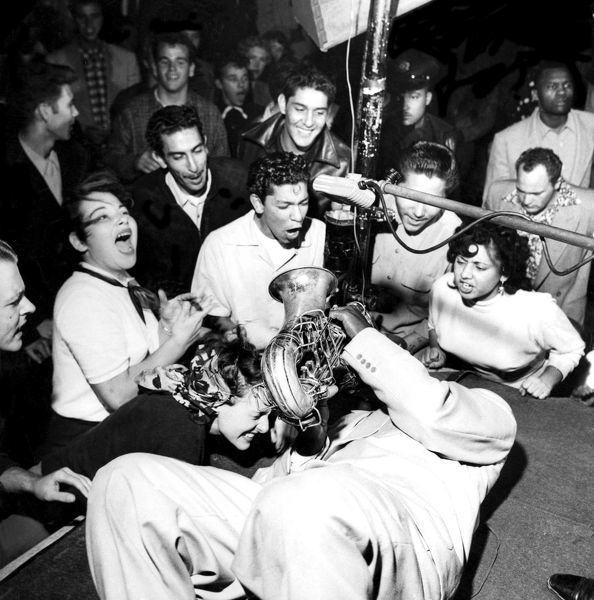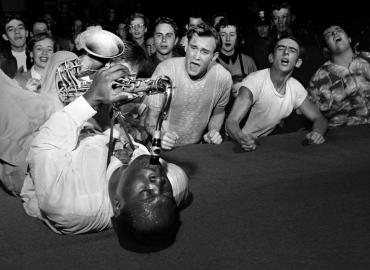There are very few live recordings of early pioneering Blues, Jazz, and Rhythm & Blues performers in their heyday. Recording technology was still in its infancy and the required budget for live recording was typically reserved for Pop stars. Studio recordings and tales of over-the-top performances are about all we have. While the Bob Willoughby image of Big Jay laying on his back “blowing his brains out” with two youths in front going even more ecstatic than the rest of the already ecstatic crowd is firmly ingrained in the collective conscious as the definitive image of post-war Rhythm & Blues most people alive today never got to witness it firsthand. Coming straight out of the church it was brash, loud, wild, and over the top in every way. Louis Jordan was the “pop star” of the sound, much as Stevie Ray Vaughan would later be the “rock star” of the Austin Blues & Roots sound, scoring the most radio hits. It’s easy to see in retrospect just how palatable Jordan could be to a wider audience but it was on Central Avenue in Watts, CA where nightclub after nightclub was jam packed with patrons blowing off steam to the “honkers”, sax players who would stretch one note to ungodly lengths driving audiences into a frenzy. Big Jay McNeely was the “king of the honkers” and outlived them all too, passing away in 2018 after playing his own 91st birthday four months earlier.
Big Jay McNeely Live At Birdland 1957 gives us one of the very few examples left for posterity of those sweat drenched stages. We get to hear him in the full glory of his youth playing in front the kind of audience that helped forge the sound. The song list is ranges from the expected to the delightfully unexpected. Big Jay’s single “Insect Ball” comes in after the opening number and the Bill Doggett hit “Honky Tonk” that became a standard is also present along with Big Jay’s anthem “Deacon’s Hop”.
Of course his biggest hit of all “There is Something On Your Mind” is also present. Recorded in 1957 and later recorded by B.B. King, Albert King, Professor Longhair, Buddy Guy, Sleepy LaBeef, Freddie Fender, Gene Vincent, and most recently by Samantha Fish, “There Is Something On Your Mind” was Big Jay’s biggest and most enduring hit. Here we get to hear it performed live when when it was a brand new hit in front of an audience who helped make it a hit.
Like his contemporaries (and guitar legend Mickey Baker) Big Jay started out playing Jazz, formally educated in music theory, harmony, and arranging. Running around with Charlie Parker was probably a lot of fun but with Jazz not quite the popular music it previously was and the emerging Bop having little room at the top it was soon evident that Rhythm & Blues was the way to go and thus a new style was forged. Jazz did not disappear from the picture, though, and while the subtleties and nuances remained, as well as the swing, it was pared down much as the the rhythm was being pared down to The Big Beat. Ray Charles’ “I’ve Got A Woman” shows up here and unsurprisingly since it was not only a hit but also followed the same formula of combining church and secular music. Jazz still had its place in the Big Jay picture and we get to hear him let loose on several Jazz numbers. “Things Ain’t What They Used To Be” is a 12 bar Blues that became a Jazz standard, much like Jimmy Smith’s “Back At The Chicken Shack” which even Muddy Waters recorded. The big surprise here is the Les Paul & Mary Ford hit “How High The Moon”. What a treat to hear it interpreted this way! One of the numbers that Big Jay and his contemporaries used to hone their craft was “Flying Home”, the Benny Goodman number co-written with Lionel Hampton and featuring electric guitar pioneer Charlie Christian on guitar in 1939 and tenor sax pioneer Illinois Jacquet in 1942. Big Jay and company tear through the number at breakneck speed with a pending backbeat and the most unearthly sounds ever to be squealed out of a saxophone. You’re going to need a cigarette when it’s done.
This album is time capsule, a memento from a world that gave birth to new sounds and changed music around the world forever. Most important of all it demonstrates clearly why this music took over during its time and remains influential to musicians and just plain fun to listers more than six decades later. As the man himself would say, “Oh yeah!”
Big Jay McNeely Live At Birdland 1957 gives us one of the very few examples left for posterity of those sweat drenched stages. We get to hear him in the full glory of his youth playing in front the kind of audience that helped forge the sound. The song list is ranges from the expected to the delightfully unexpected. Big Jay’s single “Insect Ball” comes in after the opening number and the Bill Doggett hit “Honky Tonk” that became a standard is also present along with Big Jay’s anthem “Deacon’s Hop”.
Of course his biggest hit of all “There is Something On Your Mind” is also present. Recorded in 1957 and later recorded by B.B. King, Albert King, Professor Longhair, Buddy Guy, Sleepy LaBeef, Freddie Fender, Gene Vincent, and most recently by Samantha Fish, “There Is Something On Your Mind” was Big Jay’s biggest and most enduring hit. Here we get to hear it performed live when when it was a brand new hit in front of an audience who helped make it a hit.
Like his contemporaries (and guitar legend Mickey Baker) Big Jay started out playing Jazz, formally educated in music theory, harmony, and arranging. Running around with Charlie Parker was probably a lot of fun but with Jazz not quite the popular music it previously was and the emerging Bop having little room at the top it was soon evident that Rhythm & Blues was the way to go and thus a new style was forged. Jazz did not disappear from the picture, though, and while the subtleties and nuances remained, as well as the swing, it was pared down much as the the rhythm was being pared down to The Big Beat. Ray Charles’ “I’ve Got A Woman” shows up here and unsurprisingly since it was not only a hit but also followed the same formula of combining church and secular music. Jazz still had its place in the Big Jay picture and we get to hear him let loose on several Jazz numbers. “Things Ain’t What They Used To Be” is a 12 bar Blues that became a Jazz standard, much like Jimmy Smith’s “Back At The Chicken Shack” which even Muddy Waters recorded. The big surprise here is the Les Paul & Mary Ford hit “How High The Moon”. What a treat to hear it interpreted this way! One of the numbers that Big Jay and his contemporaries used to hone their craft was “Flying Home”, the Benny Goodman number co-written with Lionel Hampton and featuring electric guitar pioneer Charlie Christian on guitar in 1939 and tenor sax pioneer Illinois Jacquet in 1942. Big Jay and company tear through the number at breakneck speed with a pending backbeat and the most unearthly sounds ever to be squealed out of a saxophone. You’re going to need a cigarette when it’s done.
This album is time capsule, a memento from a world that gave birth to new sounds and changed music around the world forever. Most important of all it demonstrates clearly why this music took over during its time and remains influential to musicians and just plain fun to listers more than six decades later. As the man himself would say, “Oh yeah!”






 RSS Feed
RSS Feed